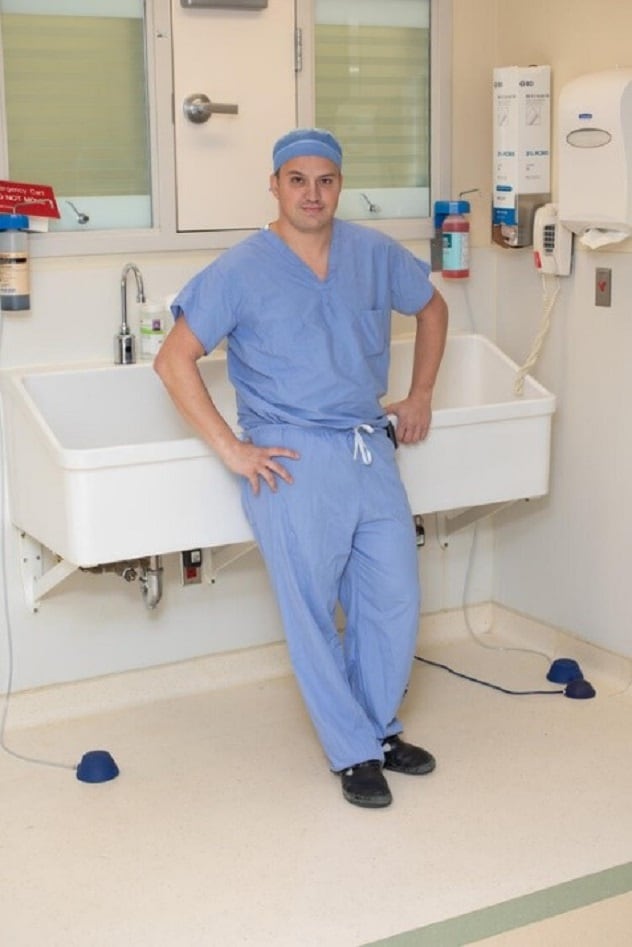March 19, 2024
In 2023, an individual stabbed a Minnesota teen boy in the chest following an altercation while the boy was bike riding. The boy rode home, and his family called for help. Emergency medical services (EMS) transported him to a local yet limited-resource hospital. Trauma professionals performed lifesaving measures for the boy, including tracheal intubation to maintain an open airway.
An air ambulance from Mayo Clinic Ambulance Service flew to meet the injured boy at the Minnesota hospital, transporting him to Mayo Clinic in Rochester, Minnesota. Treatment continued throughout the air ambulance flight, including blood transfusion and ventilation support. At Mayo Clinic, trauma professionals decided to continue chest tube use, performed a chest X-ray to assess the injuries and search for any foreign bodies present from the stabbing, and administered blood products.
 د. دانيال ستيفنز في مايو كلينك في ولاية مينيسوتا
د. دانيال ستيفنز في مايو كلينك في ولاية مينيسوتا
تعاوَن د. دانيال ستيفنز (في مايو كلينك في ولاية مينيسوتا) مع الأطباء في مركز علاج الإصابات الجسدية التعاوني الإقليمي للمساعدة على إنقاذ حياة مراهق تعرَّض للطعن.
Daniel Stephens, M.D., trauma surgeon and adult medical director of Mayo Clinic Trauma Center, met the patient in the trauma bay. From there, trauma professionals moved him immediately to the operating room. Dr. Stephens and team performed a thoracotomy, opening the patient's left chest and discovering massive bleeding and damage to the left lung. Survival rates are low for these injuries, according to Dr. Stephens. He sutured the injured vessels and the lung laceration, then closed after the two-hour surgery.
Dr. Stephens admitted the patient to the ICU of Mayo Clinic Hospital — Rochester, Saint Marys Campus, where he was extubated the next day. Over approximately one week, Dr. Stephens and team rounded on the boy daily to assess postsurgical progress until dismissal.
Dr. Stephens credits the boy's family for its rapid action to obtain medical assistance, and he also recognizes the EMS and the local hospital professionals for saving the boy's life.
"He was lucky in that he quickly got to a local hospital, where he was stabilized," says Dr. Stephens.
Despite a grave chest injury, the boy's long-term prognosis is good, says Dr. Stephens, who indicates the patient should experience a normal post-treatment life span due to his age and good health.
"Even small communities need to be familiar with penetrating trauma, as injury can occur anywhere."
Perspective on penetrating trauma in Mayo Clinic Trauma Center's regional collaboratives
Penetrating trauma of all types has increased in Rochester and in other areas served by Mayo Clinic Trauma Center, says Dr. Stephens. This increase corresponds with growth in population density and drug misuse, particularly opioids and methamphetamine.
Despite this growth, Dr. Stephens indicates he observed far greater volumes of penetrating trauma where he trained at Northwestern University, located near Chicago, and at the University of Minnesota in Minneapolis.
"Our region is still nowhere close to the penetrating trauma rates I saw during my training," he says. "There is no cause for people to be alarmed day to day.
"Yet, even small communities need to be familiar with penetrating trauma, as injury can occur anywhere," says Dr. Stephens.
Dr. Stephens recommends keeping the following in mind if a patient with a penetrating trauma presents at your trauma center:
- Recall your Advanced Trauma Life Support training and consider taking this course frequently.
- Consider additional training such as Advanced Surgical Skills for Exposure in Trauma.
- Call early for transport and consultation.
For more information
Refer a patient to Mayo Clinic.